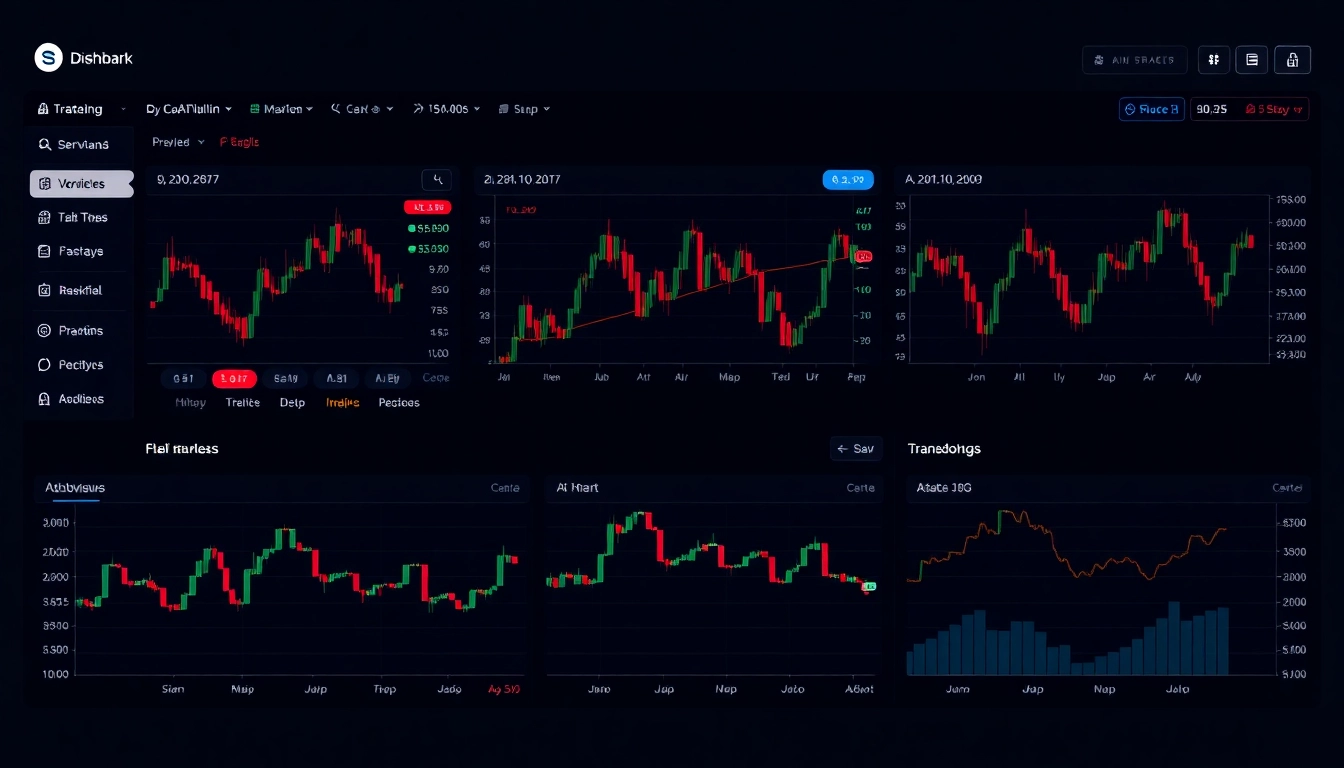Understanding Trading View: Features and Functionalities
In today’s fast-paced financial markets, having access to advanced charting tools and real-time data is essential for traders and investors seeking an edge. trading view has emerged as a leading platform, seamlessly integrating comprehensive charting capabilities with social trading features. This combination creates an environment that supports technical analysis, market discussions, and strategic decision-making all within a single platform. To fully leverage what TradingView offers, it’s vital to understand its core features, how they work together, and the advantages they bring to traders at every experience level.
Overview of Trading View’s Charting Tools
One of the cornerstone features of TradingView is its powerful, intuitive charting tools. The platform’s charting interface is designed for clarity and flexibility, accommodating both novice traders and seasoned analysts. Users can customize chart types—candlestick, line, bar, area, and more—depending on their analytical preferences. Advanced drawing tools allow for trend lines, Fibonacci retracements, Gann fans, and various shapes to identify key levels and patterns.
Moreover, TradingView supports multiple timeframes, from one minute to monthly charts, enabling granular or broad market perspectives. Its high-resolution graphical rendering ensures that even complex patterns are displayed sharply and clearly. The platform also allows for multiple chart layouts, making it possible to analyze various assets side by side simultaneously. This multifunctionality enhances the decision-making process by providing a holistic market view within a single interface.
Another notable aspect is the extensive library of indicators and oscillators. Users can utilize popular tools such as Moving Averages, Bollinger Bands, RSI, MACD, and custom indicators created via Pine Script, TradingView’s proprietary scripting language. This flexibility fosters sophisticated technical analysis tailored to individual trading strategies.
Key Market Indicators and Data Integration
TradingView’s strength lies in its seamless delivery of real-time market data. The platform aggregates data from multiple exchanges and financial data providers, ensuring users have access to accurate and up-to-minute information across global markets – stocks, cryptocurrencies, forex, commodities, and indices. This integration simplifies the process of monitoring diverse asset classes without toggling between platforms.
Users can incorporate a comprehensive suite of indicators into their charts, including volume, volatility measures, and customized overlays. For example, traders can track Bitcoin’s price movements alongside traditional stocks or monitor currency pairs relative to economic events. Additionally, TradingView offers data overlays such as economic calendars and earnings reports, enriching analysis with broader macroeconomic context.
Automation and alerts are crucial for timely decision-making. TradingView enables users to set alerts based on price levels, indicator crosses, or pattern recognitions. These alerts can be delivered via email, SMS, or platform notifications, allowing traders to act swiftly without constantly monitoring their screens.
Using Social Features for Market Insights
Unlike many standalone charting tools, TradingView integrates a vibrant social community where traders share ideas, strategies, and insights. This feature transforms the platform into a collaborative space that enhances learning and market analysis. Users can publish their own trading ideas, annotated charts, and detailed analysis to the public or private groups.
Community ideas serve as a valuable resource for spotting emerging trends, validating strategies, and gaining different perspectives. Traders often comment on ideas, providing feedback, alternative analyses, or discussing potential trade setups. Access to diverse viewpoints from thousands of traders worldwide enables a more comprehensive understanding of market dynamics.
Furthermore, TradingView’s social features enable real-time discussion through integrated chat groups, direct messaging, and follower systems. These interactions foster a sense of community and facilitate mentorship, especially for beginners learning from experienced traders.
Getting Started with Trading View: Setup and Customization
Creating Your Trading Dashboard
Starting with TradingView involves creating an account—free tiers provide substantial functionality, and premium plans unlock additional features. Once registered, traders can customize their dashboards with multiple chart layouts, watchlists, and news feeds tailored to their favorite assets and markets.
Organize your workspace by clustering related charts and indicators, ensuring rapid access during live trading sessions. Using predefined templates or creating custom ones allows for consistency across analysis sessions, saving time and reducing errors.
Personalizing Watchlists and Alerts
Effective trading hinges on monitoring relevant assets. TradingView’s watchlists are highly customizable, enabling traders to track specific stocks, cryptocurrencies, forex pairs, or commodities. Users can group assets into folders for efficient navigation and set alerts for each asset at key price levels or indicator states. These alerts ensure traders never miss critical movements and can automate parts of their decision process.
For example, a trader interested in tech stocks can set alerts for Apple, Microsoft, and Google at support or resistance levels, receiving immediate notifications when prices breach these thresholds.
Integrating Trading View with Other Platforms
Though TradingView itself is comprehensive, integration with other trading platforms and brokers enhances operational efficiency. The platform offers trading execution via supported brokers, allowing order placement directly from charts. It also supports exporting data or charts for external analysis or reporting.
Furthermore, API integrations and third-party plugins expand functionalities, such as automating strategies or syncing layouts with trading software. These enhancements streamline workflows and allow traders to maintain a cohesive ecosystem.
Advanced Trading Strategies Using Trading View
Technical Analysis and Pattern Recognition
Advanced traders leverage TradingView’s pattern recognition and indicator overlays to identify potential trade setups. Recognizable formations such as head and shoulders, double tops, triangles, and wedges are easily marked and analyzed with the platform’s drawing tools. Combining these with oscillator signals and trend indicators increases the reliability of trade signals.
For example, recognizing a converging triangle pattern combined with RSI divergence can indicate an upcoming breakout, prompting timely entry or exit decisions.
Implementing Backtesting for Strategy Validation
Backtesting is fundamental to validating a trading approach before risking real capital. TradingView’s integrated Pine Script facilitates scripting and testing strategies against historical data. Traders can develop custom indicators, automate buy/sell signals, and evaluate performance metrics such as win rate, profit factor, and maximum drawdown.
Systematic backtesting enables traders to refine their strategies under varied market conditions, optimizing parameters to improve robustness before deployment in live trading.
Leveraging Scripts and Indicators for Precise Entry and Exit Points
The ability to create or utilize existing Pine Script indicators allows traders to develop highly customized tools. Combining multiple indicators—like Stochastic and Moving Average Crossovers—can generate precise entry and exit signals, reducing emotional bias and increasing consistency.
Additionally, alert-based trading entries ensure timely execution once conditions are met, enhancing effectiveness, especially in volatile markets such as cryptocurrencies.
Maximizing Market Insights: Tips and Best Practices
Analyzing Multiple Markets Simultaneously
Efficient traders monitor several assets to diversify risk and capitalize on macro trends. TradingView’s multi-pane layout, synchronized timeframes, and cross-asset overlays support this approach. For example, observing the relationship between dollar strength and commodity prices on adjacent charts provides comprehensive insight into broader market movements.
Utilizing Community Ideas and Trader Collaboration
Engaging with the TradingView community can accelerate learning and improve analysis quality. Regularly reviewing top-rated ideas, participating in discussions, and exchanging feedback help traders validate assumptions and discover new strategies. This collaborative environment fosters continuous improvement and supports adaptation to market changes.
Monitoring Market Trends with Real-Time Alerts
Setting appropriate alerts based on technical levels or pattern formations ensures swift reactions. For instance, alerting when major support levels are broken or when bullish divergences appear helps traders capitalize on emerging moves promptly. Properly configured alerts reduce analysis paralysis by focusing on actionable events.
Measuring Success and Optimizing Your Usage of Trading View
Tracking Performance Metrics and Outcomes
Consistent review of trading results using platform analytics or external tracking tools helps traders evaluate strategy effectiveness. Metrics such as risk-reward ratio, win rate, and drawdown are essential for refining approaches. TradingView’s strategy tester provides a clear view of historical performance to guide adjustments.
Adjusting Strategies Based on Data Insights
Data-driven decisions lead to sustainable trading. Continuous analysis of past trades and indicator signals informs modifications—whether tuning indicator sensitivity, altering stop-loss levels, or redefining entry criteria. Adapting strategies based on empirical evidence enhances profitability over time.
Staying Updated with Platform Updates and New Features
Trading platforms evolve rapidly. Keeping abreast of new features, tools, and updates through official channels ensures users leverage the platform’s full potential. Engaging with tutorials, webinars, and community feedback keeps skills sharp and strategies current.







